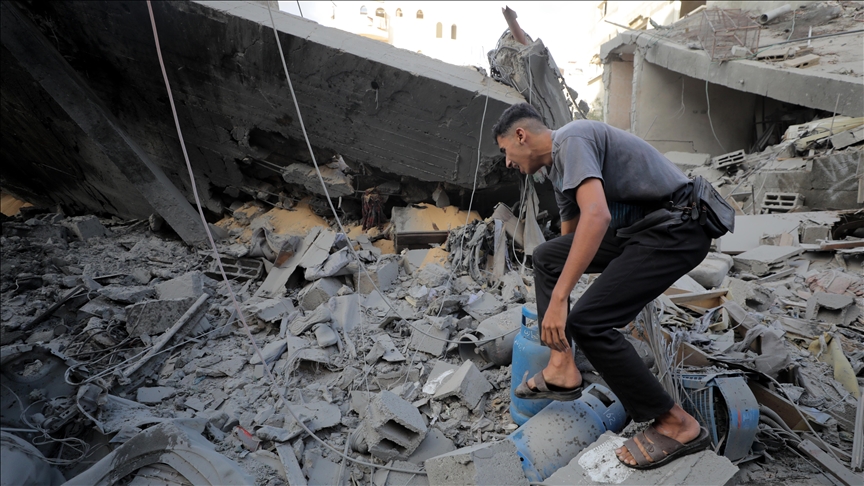– 87,000 homes have been leveled in the enclave, with damage to critical infrastructure estimated to have accrued to approximately $18.5B and resulting in the internal displacement of at least 1.9M
– A total of 456 schools, universities and university buildings have been the target of Israeli attacks, while 32 damaged hospitals and 115 ambulances have been affected
ISTANBUL
Israel’s genocidal war on Gaza is undoubtedly one of the most destructive conflicts of the 21st century, with 41,825 fatalities, 96,910 injuries, and more than 10,000 people reported missing under the rubble.
The war has not only targeted civilians but have also left much of the enclave’s infrastructure in ruins, endangered and killed health workers, and destroyed homes, schools, and entire neighborhoods.
A year on, Anadolu takes a look into the various forms of destruction taking place in Gaza.
Educide: Destruction of education
Israel’s deadly onslaught has caused significant damage to educational institutions in Gaza.
At least 354 people were killed in Israeli airstrikes on school buildings housing displaced individuals between June 1 and Sept. 1, according to ABC News.
More than 718,000 students in Gaza have had their education disrupted by the war, with a total of 456 schools, universities and university buildings have been either damaged or destroyed, it added.
As of Aug. 27, the Ministry of Education reported that over 10,888 schoolchildren have been killed, along with 529 teachers and administrative staff. In total, 17,224 children and 3,686 teachers have been injured in Gaza.
Children in the occupied West Bank, including East Jerusalem, are also facing challenges as the school year begins.
UNICEF reports that increasing violence and movement restrictions since October 2023 have created additional obstacles to learning for the 782,000 students in the region.
Data from the Ministry of Education and the Education Cluster indicates that between 8% and 20% of schools in the West Bank have been closed since that time, according to UNICEF.
At least 45,000 six-year-old children in the Gaza Strip are missing out on their first year of school.
These first graders join 625,000 children who have already been denied an entire school year and now face a significant risk of missing a second consecutive year of education.
Ecocide: Destruction of environment
Israel’s genocidal war on Gaza has inflicted significant harm on the environment due to the munitions that have been deployed.
The term “ecocide” is defined by the European Law Institute as the “devastation and destruction of the environment to the detriment of life.”
This concept was introduced in the 1970s during the Vietnam War by American biology professor Arthur Galston, who protested the US military’s use of the herbicide and defoliant Agent Orange to eliminate foliage and crops belonging to enemy forces.
As of June, the estimated environmental cost of rebuilding Gaza was 60 million metric tons of carbon emissions, according to a study reported by broadcaster Euronews and published on the Social Science Research Network.
Emissions from the first 120 days of the conflict have exceeded the annual emissions of 26 countries and territories, with Israel accounting for 90% of this total.
A UN assessment has found that a fleet of over one hundred lorries would take 15 years to remove nearly 40 million metric tons of rubble from Gaza, with the operation costing between $500 million and $600 million, The Guardian reported in July.
The assessment found that large landfills covering between 250 and 500 hectares (618 to 1,235 acres) would be needed to dispose of the rubble, depending on the amount that can be recycled.
Domicide: Destruction of housing
Israel’s ongoing assault has also demolished much of the homes and infrastructure in Gaza.
The Housing, Land and Property Technical Working Group reported in September that at least 297,000 housing units in Gaza have sustained damage, with 87,000 completely destroyed, according to a statement from UNRWA.
The estimated cost of damage to critical infrastructure in Gaza is approximately $18.5 billion.
Of this total, 72% is attributed to damage in the housing sector, 19% to public services infrastructure, including water, health, and education, and 9% to commercial and industrial buildings.
At least 1.9 million people in the Gaza Strip are internally displaced, including those who have been displaced multiple times, according to the UN.
Destruction of health care
According to WHO, Israel carried out 516 attacks targeting the Palestinian healthcare system in Gaza and 619 in the occupied West Bank including East Jerusalem between Oct. 7 last year and Sept. 23.
Attacks on health care claimed the lives of 765 people, affecting 110 facilities, as well as 32 damaged hospitals and 115 ambulances, including 63 that sustained damage.
In the occupied West Bank, including East Jerusalem, there have been 25 deaths and 111 injuries, with 444 ambulances and 56 health facilities affected by attacks targeting the health care.
Destruction of culture
Israeli bombings in Gaza have also targeted the enclave’s historical heritage.
According to UNESCO, as of Sept. 17, Israel has damaged 69 sites in Gaza, including 10 religious sites, 43 buildings of historical and/or artistic significance, two depositories of movable cultural property, six monuments, one museum, and seven archaeological sites.

